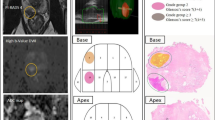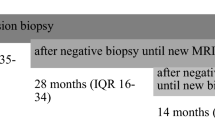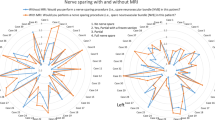Abstract
Background
Prostate multiparametric magnetic resonance imaging (mpMRI) has become a popular initial investigation of an elevated PSA and is being incorporated into active surveillance protocols. Decisions on prostate cancer investigation and management based solely on a normal mpMRI remains controversial. Histopathological findings of a totally embedded normal mpMRI lobe are rarely described.
Methods
A retrospective review of the histological findings of negative preoperative mpMRI lobes in men treated by robot assisted laparoscopic radical prostatectomy (RALP). Inclusion criteria included a preoperative low risk mpMRI for both lobes (Prostate Imaging–Reporting and Data System (PIRADS) ≤ 2) or one negative lobe (with a PIRADS 3–5 in the opposite lobe).
Results
A single normal mpMRI lobe was identified in 1018 men (PIRADS 3–5 group). Both lobes were normal in 179 men (PIRADS ≤ 2 group). Prostate cancer was identified in 47.6% (485/1018) of the normal mpMRI lobe opposite a PIRADS 3–5 lesion, including 13.2% (134/1018) with >0.5 cc of International Society of Urologic Pathologists (ISUP) grade 2, or a higher grade cancer. ISUP grade 4–5 was only identified in 2% (20/1018). Compared to RALP histology of the PIRADS 3–5 mpMRI tumour, a pathological ISUP upgrade in the normal mpMRI lobe was identified in 58/1018 men (5.7%). In the PIRADS ≤ 2 group extraprostatic extension occurred in 19% (34/179) and seminal vesicle invasion (pT3b) in 3.9% (7/179). There was no difference in margin status between the PIRADS 3–5 and ≤2 groups (p = 0.247).
Conclusions
mpMRI underestimates tumour grade and volume compared to totally embedded histopathological analysis of RALP specimens, although ISUP grade 4–5 cancer is uncommon. Our analysis provides useful insight into the multifocality of prostate cancers, and highlights the utility of systematic biopsy, in addition to targeted biopsies. These results have ramifications for clinical decisions on prostate cancer management based solely on the mpMRI appearance, including active surveillance.
This is a preview of subscription content, access via your institution
Access options
Subscribe to this journal
Receive 4 print issues and online access
$259.00 per year
only $64.75 per issue
Buy this article
- Purchase on Springer Link
- Instant access to full article PDF
Prices may be subject to local taxes which are calculated during checkout



Similar content being viewed by others
References
Pokorny MR, Rooij M, Duncan E, Schröder FH, Parkinson R, Barentsz JO, et al. Prospective study of diagnostic accuracy comparing prostate cancer detection by Transrectal Ultrasound-Guided biopsy versus Magnetic Resonance (MR) Imaging with subsequent MR-guided biopsy in men without previous prostate biopsies. Eur Urol. 2014;66:22–9.
Ahmed HU, Bosaily AE, Brown L, Gabe R, Kaplan R, Parmar MK, et al. Diagnostic accuracy of multi-parametric MRI and TRUS Biopsy in Prostate Cancer (PROMIS): a paired validating confirmatory study. Lancet. 2017;389:815–22.
Norris JM, Carmona Echeverria LM, Bott SRJ, Brown LC, Burns-Cox N, Dudderidge T, et al. What type of prostate cancer is systematically overlooked by multiparametric magnetic resonance imaging? An Analysis from the PROMIS Cohort. Eur Urol. 2020 pii: S0302-2838(20)30261-X. https://doi.org/10.1016/j.eururo.2020.04.029.
Priester A, Natarajan S, Khoshnoodi P, Margolis DJ, Raman SS, Reiter RE, et al. Magnetic Resonance Imaging underestimation of prostate cancer geometry: use of patient specific moulds to correlate images with whole mount pathology. J Urol. 2017;197:320–6.
Rouvière O, Puech P, Renard-Penna R, Claudon M, Roy C, Mège-Lechevallier F, et al. Use of prostate systematic and target biopsy on the basis of multiparametric MRI in biopsy-naïve patients (MRI-FIRST): a prospective, multicentre, paired diagnostic study. Lancet Oncol. 2019;20:100–09.
Ahdoot M, Wilbur AR, Reese SE, Lebastchi AH, Mehralivand S, Gomella PT, et al. MRI-target, systematic and combined biopsy for prostate cancer. N Engl J Med. 2020;382:917–28.
Barentsz JO, Richenberg J, Clements R, Choyke P, Verma S, Villeirs G, et al. ESUR prostate MR guidelines 2012. Eur Radio. 2012;22:746–57.
Weinreb JC, Barentsz JO, Choyke PL, Cornud F, Haider MA, Macura KJ, et al. PIRADS prostate imaging -reporting and data system: 2015, version 2. Eur Urol. 2016;16:16–40.
Srigley JR, Delahunt B, Egevad L, Samaratunga H, Yaxley J, Evans AJ. One is the new six: The International Society of Urological Pathology patient-focused approach to Gleason grading. Can Urol Assoc J. 2016;10:339–41. https://doi.org/10.5489/cuaj.4146.
Vickers A, Carlsson S, Cooperberg M. Routine use of magnetic imaging for early detection of prostate cancer is not justified by clinical trial evidence. Eur Urol. 2020. https://doi.org/10.1016/j.eururo.2020.04.016.
Franklin A, Gianduzzo T, Yaxley J, Kua B, Coughlin G, Samaratunga H, et al. The use of a trizonal schema to assess targeting accuracy of fusion prostate biopsy. BJU Int. 2020. https://doi.org/10.1111/bju.14974.
Vargas HA, Hötker AM, Goldman DA, Moskowitz CS, Gondo T, Matsumoto K, et al. Updated imaging reporting and data system (PIRADSv2) recommendations for the detection of clinically significant prostate cancer using whole-mount pathology as standard of reference. Eur Radio. 2016;26:1606–12. https://doi.org/10.1007/s00330-015-4015-6.
Donato P, Morton A, Yaxley J, Teloken PE, Coughlin G, Esler R, et al. Improved detection and reduced biopsies: the effect of a multiparametric magnetic resonance imaging-based triage prostate cancer pathway in a public teaching hospital. World J Urol. 2020;38:371–9. https://doi.org/10.1007/s00345-019-02774-y.
Cantiello F, Russo GI, Kaufmann S, Cacciamani G, Crocerossa F, Ferro M, et al. Role of multiparametric magnetic resonance imaging for patients under active surveillance of prostate cancer: a systematic review with diagnostic meta-analysis. Prostate Cancer Prostatic Dis. 2019;22:206–20.
Chesnut GT, Vertosick EA, Benfante N, Sjoberg DD, Fainberg J, Lee T, et al. Role of changes in magnetic resonance imaging or clinical stage in evaluation of disease progression for men with prostate cancer on active surveillance. Eur Urol. 2020;77:501–7. https://doi.org/10.1016/j.eururo.2019.12.009.
Diaz AW, Shakir NA, George AK, Rais-Bahrami SR, Turkbey B, Rothwax JT, et al. Use of serial multiparametric magnetic resonance imaging in the management of patients with prostate cancer on active surveillance. Urol Oncol. 2015;33:202.e1–202.e7. https://doi.org/10.1016/j.urolonc.2015.01.023.
Hu JC, Chang E, Natarajan S, Margolis DJ, Macairan M, Lieu P, et al. Targeted prostate biopsy in select men for active surveillance: do the Epstein criteria still apply? J Urol. 2014;192:385–90. https://doi.org/10.1016/j.juro.2014.02.005.
Hsiang W, Ghabili K, Syed JS, Holder J, Nguyen KA, Suarez-Sarmiento A, et al. Outcomes of serial multiparametric magnetic resonance imaging and subsequent biopsy in men with low-risk prostate cancer managed with active surveillance. Eur Urol Focus. 2019. pii: S2405-4569(19)30148-8. https://doi.org/10.1016/j.euf.2019.05.011.
Amin A, Scheltema MJ, Shnier R, Blazevski A, Moses D, Cusick T, et al. The Magnetic Resonance Imaging in Active Surveillance (MRIAS) trial: use of baseline multiparametric magnetic resonance imaging and saturation biopsy to reduce the frequency of surveillance prostate biopsies. J Urol. 2020;203:910–7. https://doi.org/10.1097/JU.0000000000000693.
Morgan VA, Riches SF, Thomas K, Vanas N, Parker C, Giles S, et al. Diffusion-weighted magnetic resonance imaging for monitoring prostate cancer progression in patients managed by active surveillance. Br J Radio. 2011;84:31–7. https://doi.org/10.1259/bjr/14556365.
Flavell RR, Westphalen AC, Liang C, Sotto CC, Noworolski SM, Vigneron DB, et al. Abnormal findings on multiparametric prostate magnetic resonance imaging predict subsequent biopsy upgrade in patients with low risk prostate cancer managed with active surveillance. Abdom Imaging. 2014;39:1027–35. https://doi.org/10.1007/s00261-014-0136-7.
Tran M, Thompson J, Böhm M, Pullbrook M, Moses D, Shnier R, et al. Combination of multiparametric MRI and transperineal template-guided mapping biopsy of the prostate to identify candidates for hemi-ablative focal therapy. BJU Int. 2016;117:48–5.
Gallagher KM, Christopher E, Cameron AJ, Little S, Innes A, Davis G, et al. Four-year outcomes from a multiparametric magnetic resonance imaging (MRI)-based active surveillance programme: PSA dynamics and serial MRI scans allow omission of protocol biopsies. BJU Int. 2019;123:429–38. https://doi.org/10.1111/bju.14513.
Klotz L, Pond G, Loblaw A, Sugar L, Moussa M, Berman D, et al. Randomized study of systematic biopsy versus magnetic resonance imaging and targeted and systematic biopsy in men on active surveillance (ASIST): 2-year postbiopsy follow-up. Eur Urol. 2020;77:311–7. https://doi.org/10.1016/j.eururo.2019.10.007.
Jäderling F, Akre O, Aly M, Björklund J, Olsson M, Adding C, et al. Preoperative staging using magnetic resonance imaging and risk of positive surgical margins after prostate-cancer surgery. Prostate Cancer Prostatic Dis. 2019;22:391–8. https://doi.org/10.1038/s41391-018-0116-z.
Acknowledgements
We would like to thank Ricardo Maldonado from PowerStats Pty. Ltd. for his assistance in completing the statistical analysis for this manuscript.
Author information
Authors and Affiliations
Corresponding author
Ethics declarations
Conflict of interest
The authors declare that they have no conflict of interest.
Additional information
Publisher’s note Springer Nature remains neutral with regard to jurisdictional claims in published maps and institutional affiliations.
Rights and permissions
About this article
Cite this article
Yaxley, W.J., Nouhaud, FX., Raveenthiran, S. et al. Histological findings of totally embedded robot assisted laparoscopic radical prostatectomy (RALP) specimens in 1197 men with a negative (low risk) preoperative multiparametric magnetic resonance imaging (mpMRI) prostate lobe and clinical implications. Prostate Cancer Prostatic Dis 24, 398–405 (2021). https://doi.org/10.1038/s41391-020-00289-x
Received:
Revised:
Accepted:
Published:
Issue Date:
DOI: https://doi.org/10.1038/s41391-020-00289-x



